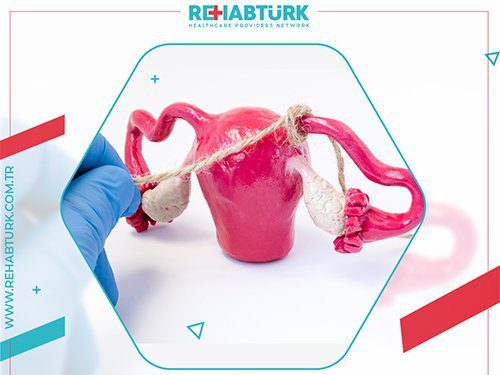Reversal of laparoscopic tubal ligation in Türkiye
A tubal ligation reversal is a procedure during which the surgeon reopens, unties or reconnects the fallopian tubes so that you can have a baby again.
When you had your tubes tied, you were probably 100% sure you didn’t want to get pregnant.
So what if you change your mind? Is there still a way to achieve this? The answer is yes. There is a tubal ligation reversal
Can I have a tubal ligation reversal?
Your doctor will consider several things before deciding whether an operation is right for you:
- Your age
- The type of duct ligation surgery you had previously
- Your general health and the health of your ovaries, uterus and remaining fallopian tubes, especially their length.
Your doctor will also ask you questions such as:
- When were your tubes tied and what type of surgery did you have?
- Have you been pregnant before and was it a healthy pregnancy?
- Have you had surgery for endometriosis, fibroids, pelvic inflammatory disease or other gynecological disorders?
Any of these surgeries can cause scar tissue, which may affect tubal reversal surgery. In general, tubal reversal may be appropriate for you if only small sections of your fallopian tubes have been removed, or if your tubes are closed with rings or clips.
Some surgeons comment that the best candidates for tubal ligation reversal are women younger than 40 who have had their tubes tied soon after giving birth, a procedure called “postpartum tubal ligation.”
Before a tubal ligation reversal

Your doctor will likely suggest that you and your partner undergo a complete physical examination. This way you can find out if there is anything that might prevent you from getting pregnant after having a Tubal Ligation Reversal.
Your examination may include blood and imaging tests to check that your ovaries are normal. You’ll also need an imaging test of your uterus and fallopian tubes to check the length and function of your remaining fallopian tubes. This can be done with dye and x-rays or saline and air with ultrasound.
Your doctor may also suggest that your partner have tests to check his sperm count and semen analysis to rule out any fertility problems.
How is the process done?
You will need to go to a hospital or outpatient centre. During the procedure you will be given general anesthesia, which means you will not feel any pain and will not be awake.
The surgeon places a small light scope, called a laparoscope, through your belly button and into your pelvic area. This allows him to look at your fallopian tubes and determine if reversible surgery is possible.
If the doctor decides it’s okay to operate, your doctor will then make a small surgical cut, or a “bikini cut,” near the pubic hair line. Microscopic instruments attached to the end of the laparoscope allow any clips or rings that were used to block off the tubes to be removed and the ends of the tubes reconnected to the uterus, using very small stitches.
The surgery usually takes about 2 to 3 hours.
Recovery after tubal ligation reversal
Recovery time depends on the surgical method your doctor used. Tubal ligation reversal is a major abdominal surgery that is more difficult and takes longer to perform than the original tubal ligation.
Some women may need to stay in the hospital for one to three days. But today, tubal ligation reversal surgery is often done using “ microsurgical ” techniques. An overnight stay in the hospital may not be required. Women who have the microsurgical procedure usually go home the same day, within 2 to 4 hours after the surgery is completed.
Your doctor will prescribe pain relievers to help you get rid of any pain. Most women return to their normal activities within two weeks after the operation.
Pregnancy success rates after tubal ligation reversal
If your remaining fallopian tubes are healthy, and you and your partner don’t have any other infertility issues, you have a good chance of becoming pregnant after a tubal reversal.
However, keep in mind that it does not benefit all patients as age plays an important role in determining whether you will get pregnant after a tubal reversal. Older women are less likely to succeed than younger women.
In general, pregnancy success rates range from 40% to 85%. When pregnancy occurs, it is usually in the first year. In addition to the age factor, getting pregnant after a fallopian tube reconstruction procedure depends on things like:
- The type of tubal ligation surgery you had previously
- The length of the remaining fallopian tubes and whether they are still working properly.
- The amount of scar tissue present in the pelvic area
- Results of your partner’s sperm count and other fertility tests
- Your surgeon’s skill
You will need another X-ray test (salpingo-hysterosalpingography) about 3 to 4 months after surgery to check that your tubes are open and working properly.
Complications and risks of the operation
All surgeries carry some risks. Complications are rare, but you may have bleeding, infection, damage to nearby organs, or side effects of the anesthesia. Tubal reversal can also increase the risk of an ectopic pregnancy, a life-threatening condition in which a fertilized egg develops outside the uterus.
Sometimes the area where the tubal reversal was performed forms scar tissue and blocks the fallopian tube again.
How much does a tubal ligation reversal cost?
Insurance usually does not cover this procedure. Reversing the trumpet is very expensive. There is the surgery, along with the anesthesia, hospital fees, and the cost of the fertility tests you need before the procedure.
alternatives to this process
You may want to consider in vitro fertilization. In this procedure, a man’s egg and sperm are fertilized in a laboratory outside the uterus. The fertilized egg (embryo) is later placed in your uterus IVF is also an option if you do not become pregnant after tubal reversal surgery
Tubal ligation reversal surgery in Türkiye
If you want to undergo a tubal ligation reversal in Türkiye, you can contact directly with the doctors of REHABTÜRK to find out the cost, and we can also secure a medical invitation to help you obtain a visa, if your travel to Türkiye requires a visa.
How can I book for tubal ligation reversal surgery in Türkiye?

- Free medical support on the phone: You will have a dedicated representative for your health condition who is always ready to answer your questions.
- Free consultation with a specialist doctor: Your medical representative will consult with a number of doctors and hospitals to find the best possible treatments.
- Free travel visa arrangement: We will contact the embassy in your country to assist you in obtaining a visa to visit Türkiye.
- Free itinerary planning: We will create a schedule for your medical trip to Türkiye.
- Free translation of documents and reports: We will translate medical documents and reports into Turkish on your behalf.
- Free support and monitoring: We will monitor the stages of treatment and be by your side every step of the way.
- Free instant translation: We will be with you during the treatment stages to provide translation between you and the medical team.
- Free accommodation and transportation coordination: We will book accommodation for you and your companions in Türkiye, along with transportation services.
Contact REHABTÜRK doctors for more information about the procedure and to evaluate your medical condition.
